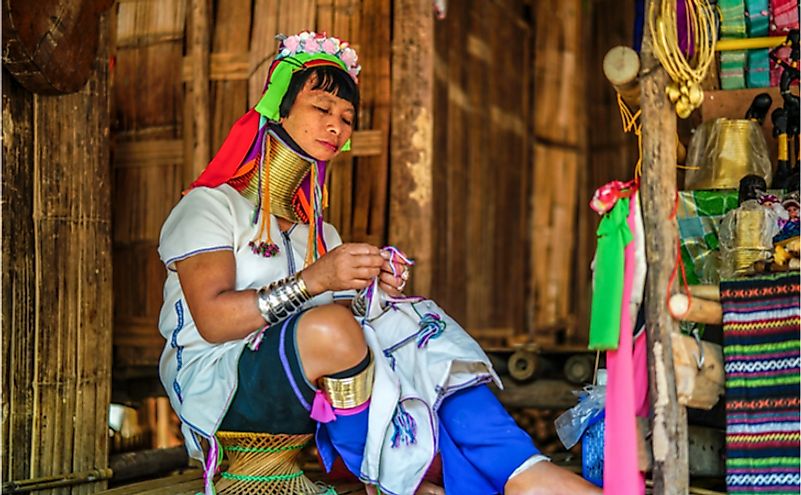Top 10 Interesting Facts About Myanmar (Burma)

Myanmar or Burma is a beautiful Southeast Asian nation with great potential to serve as a major regional tourist destination. It has enchanting natural landscapes and unique cultures that are waiting to be explored. The country is bordered by India, Bangladesh, China, Thailand, and Laos. Here is a list of some of the most interesting facts associated with this Myanmar.
10. Burmese Fishermen Fish On One Leg -
An unusual technique is used by Burmese fishermen to catch fish. They carefully balance on one leg while they wrap their second leg around the oar of their boat to guide the vessel through the water. This allows the fishermen to keep both hands free to hold fishing nets and also stand and search for reeds in the water. Inle Lake in the Taunggyi District is one of the best places in the country to watch these fishermen in action.
9. Inle Lake Hosts Species Found Nowhere Else In The World -

Inle Lake is Myanmar's second-largest lake and occupies an area of around 116 square km. It is also located at an elevation of 880 m and has a maximum depth of 3.7 m. Although the Inle Lake is relatively small compared to other lakes in the world, it hosts several endemic species including 20 species of snails and 9 fish species. Examples include Sawbwa barb, Lake Inle danio, and crossbanded dwarf danio. The Inle Lake was designated a Ramsar site in 2018.
8. Pagoda Festivals Are Popular In Myanmar -

Pagoda festivals are held throughout the country and are dictated by the Burmese calendar. They celebrate the founding day of a pagoda and the crowning of its umbrella or hti. These festivals are similar to agricultural shows or carnivals and play an important role in the life of the native Burmese people. These festivals help keep ancient traditions and practices alive.
7. Bagan, The Land Of Thousands Of Buddhist Temples -

Bagan in Myanmar is an ancient city that was designated as a UNESCO World Heritage Site in 2019. It served as the capital of the Pagan Kingdom of Myanmar from the 9th to 13th centuries. During this time, 4,446 Buddhist temples, monasteries, and pagodas were constructed in Bagan of which 3,822 still survive today. Currently, the Burmese government is trying to promote Bagan as the central feature of the nascent tourism industry in the country.
6. Fish Is Extensively Used In Burmese Cuisine -

A variety of fish products are used in Burmese cuisine. Some examples include ngapi or fermented seafood, dried prawn, and fish sauce. While seafood is a common ingredient in Myanmar's coastal cities, freshwater shrimp and fish are consumed inland as the main protein source. Fish is prepared in a variety of ways.
5. Myanmar Produced Best Quality Jadeite In The World -
Myanmar has a thriving jade trade. It is one of the world's largest mining, distribution, and manufacturing hubs of a variety of jade called jadeite. Most of the jadeite exported from Myanmar is uncut and is used in jewelry and other products. The jadeite deposits in the country's northern region are of the highest quality in the world. Up to 70% of the world's high-quality jadeite comes from Myanmar.
4. Myanmar Or Burma, Which Name To Use? -
In 1989, the military junta of Burma officially changed the name of the country to "The Republic of the Union of Myanmar." However, the name was not accepted by many world governments due to the infamous association of the junta with civil war in the country and human rights violations. However, today Myanmar is also popularly used. The victory of Aung San Suu Kyi's and the progress of the tourism industry in the country allowed this to happen.
3. Myanmar Is The World's Second Biggest Opium Producer -
Opium production is one of the major contributors to the GDP of Myanmar. The country ranks second in the world in opium production after Afghanistan. About 25% of the global opium is produced in the country. The opium industry active in the country has been illegally exploited by corrupt people to manufacture heroin. According to the United Nation, 37,300 hectares of land in Myanmar was dedicated to opium cultivation in 2017.
2. A Burmese Pagoda Is Believed To Have Hair From The Head Of Lord Buddha -

The Shwedagon Pagoda is a gilded Buddhist stupa located in Yangon, Myanmar. Located on Singuttara Hill, it is the most prominent structure in the Yangon skyline. It is considered to be the country's most sacred pagoda as it houses important relics including the water filler of Koṇāgamana, Kakusandha's staff, a piece of Kassapa's robe, and most importantly, eight strands of hair from the head of Gautama Buddha.
1. The Kayan Women Of Myanmar Wear Neck Rings -

The Kayan people are an ethnic minority group in Myanmar whose women are famous for wearing brass neck coils. Girls first start wearing the rings when they are around five years old. Gradually, the number of coils is increased so that the weight of the brass pushes their collar bone down to compress the rib cage. The origin of this culture is debated. According to some beliefs, the coils were meant to protect women from slavery or wild animals while others believe that it made them more attractive to men in their tribe.











